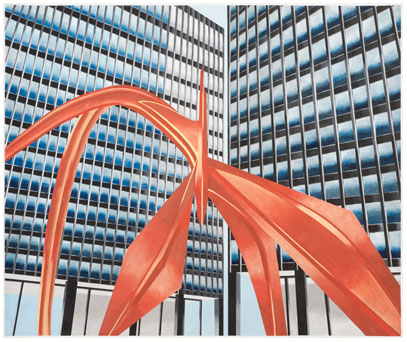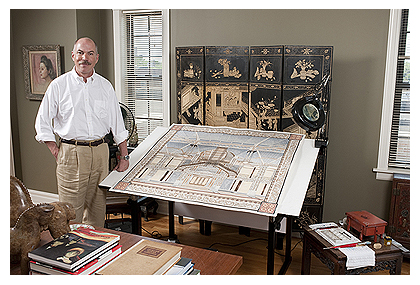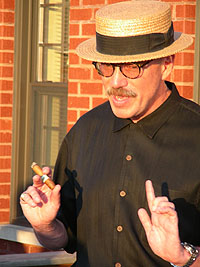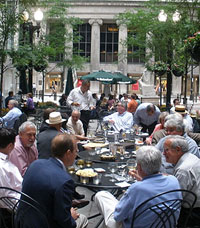|
|
|
|
|
|
|
|
Augustus
Higginson on
The Rise
of the
Skyscraper in
Chicago
Part II: From 1955 to the Trump Tower
Tuesday,
March 22, 5:30-8:30pm
19 South Wabash, 2d floor
Cocktails at
5:30, presentation 6:00-6:30 followed by discussion and more
cocktails. $40 includes drinks, two cigars,
and sandwiches.
Reservations are required.
Chicago was the birthplace of the
skyscraper, as Augustus Higginson recounted in
the first half of this lecture, one year ago. He
 now
takes on the second half of the story. In 1955, Richard J.
Daley became mayor of Chicago. Prior to his election, nothing of
significance had been built in the City for over twenty years,
due in large part to the Depression and World War II. The 1950s
and 60s, the years most closely associated with his tenure, saw
unbridled growth and expansion in the urban landscape of
America’s large cities. Chicago was no exception, as its second
great skyscraper period was about to begin, this time at the
hands of an entirely new group of architects. Chief among them
was Ludwig Mies van der Rohe, who brought the ideas of the
Bauhaus of his native Germany to America in 1938. Reshaping the
campus at I.I.T. and designing the Lake Shore Drive Apartments a
decade later, his philosophy of elegance through reduction
became the hallmark of the new look. Soon monolithic skyscrapers
began to take form at the hands of his followers, including
Walter Netsch, Bruce Graham, Adrian Smith, and Charles Murphy
--, their sleek glass-and-steel curtain walls soaring to new
heights and changing the look of Chicago permanently. now
takes on the second half of the story. In 1955, Richard J.
Daley became mayor of Chicago. Prior to his election, nothing of
significance had been built in the City for over twenty years,
due in large part to the Depression and World War II. The 1950s
and 60s, the years most closely associated with his tenure, saw
unbridled growth and expansion in the urban landscape of
America’s large cities. Chicago was no exception, as its second
great skyscraper period was about to begin, this time at the
hands of an entirely new group of architects. Chief among them
was Ludwig Mies van der Rohe, who brought the ideas of the
Bauhaus of his native Germany to America in 1938. Reshaping the
campus at I.I.T. and designing the Lake Shore Drive Apartments a
decade later, his philosophy of elegance through reduction
became the hallmark of the new look. Soon monolithic skyscrapers
began to take form at the hands of his followers, including
Walter Netsch, Bruce Graham, Adrian Smith, and Charles Murphy
--, their sleek glass-and-steel curtain walls soaring to new
heights and changing the look of Chicago permanently.
Augustus
Higginson is a local artist, architectural
historian, and Cigar
 Society
member. Born and raised in Southern California, he earned a BA
at the University of California at Santa Barbara in Art History,
and an MA in Architectural History from the University of
California at Davis. Over the last four years Gus has made his
home in Chicago, bringing together his passion for architecture
both in teaching and in his unique canvases. (The painting of
the Federal Center, above, is one of his recent works.)
Here he is pictured in his Lake View Studio. Society
member. Born and raised in Southern California, he earned a BA
at the University of California at Santa Barbara in Art History,
and an MA in Architectural History from the University of
California at Davis. Over the last four years Gus has made his
home in Chicago, bringing together his passion for architecture
both in teaching and in his unique canvases. (The painting of
the Federal Center, above, is one of his recent works.)
Here he is pictured in his Lake View Studio.
March 22 - On this date in 1733, Joseph
Priestly invented seltzer water, thus making possible the scotch
and soda.
|
|
|

Coming up
Tuesday, April 5
Tony Grosch,
The Ideal of Brotherhood in Four
Classic Chicago Novels in the '30s and '40s.
19 S. Wabash, 2d floor.
Tuesday, April 12
Lauren Viera,
New Cocktails for Spring: A Lesson in
Mixology.
19 S. Wabash, 2d floor.
Tuesday, April 26
Michael Turner,
God, the Multiverse, and Cosmic
Arrogance.
19 S. Wabash, 2d floor.
Tuesday, May 10
Robert Wallace,
Why did the Athenians Kill
Socrates?
19 S. Wabash, 2d floor.
Tuesday, May 24
Alfred Rasho,
Making Short Documentary Films.
19 S. Wabash, 2d floor.
In June thru August the Cigar Society will meet
every nice Tuesday at the Ceres Cafe, outdoors, next to the
Board of Trade Building and Jack Schwartz cigars.

|
|
|
|
|
|
|
|
About
the Cigar Society of Chicago
ONE OF THE OLDEST AND greatest
traditions of the city clubs of Chicago is the discussion of
intellectual, social, legal, artistic, historical, scientific,
musical, theatrical, and philosophical issues in the company of
educated, bright, and appropriately provocative individuals, all
under the beneficent influence of substantial amounts of tobacco
and spirits. The
Cigar Society of Chicago embraces this tradition and
extends it with its Informal Smokers,
University Series lectures, and Cigar Society Dinners,
in which cigars, and from time to time pipes and cigarettes,
appear as an important component of our version of the classical
symposium. To be included in the Cigar Society's
mailing list, write to the Secretary at
CigarSociety@logicophilosophicus.org.
|
|
|
|